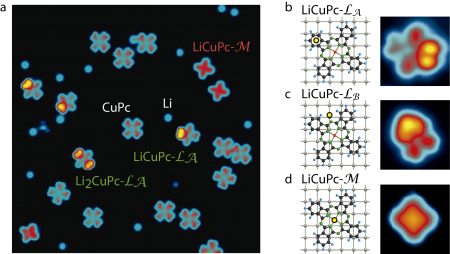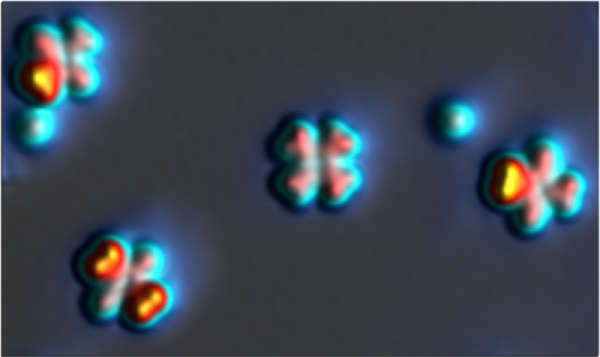Ligand chemistry can be a powerful tool to tailor the electronic and magnetic properties of individual atoms, as well as their interactions at the interface with other inorganic materials. The latter is crucial, since the presence of interfacial interactions can strongly perturb the molecular properties, but also induce new charge and spin configurations, hybrid states, or topological phases. Controlling such interactions requires an atomic scale understanding of the correlation between structural, electronic and magnetic properties. In our group we study this correlation of local properties, providing insight in the effect of interactions on the interfacial properties, and examine different manipulation strategies to control them.
Inducing chirality with achiral molecules
Chiral surfaces have assumed central importance to a diverse range of investigations, including the enantiomerically pure compounds, production of the amplification of nonlinear optical properties and the asymmetric scattering of spin-polarized electrons. A particularly efficient way of bestowing chirality to surfaces relies on the deposition of organic molecular films.
In a study of the adsorption of CuPc on the Ag(100) surface [Phys. Rev. Lett. 105 115702 (2010)], we have shown that the chiral induction at the surface can be of purely electronic origin, i.e. restricted to frontier molecular orbitals and leaving the molecular conformation unperturbed. The electronic chirality is originated from the mismatch between molecular and surface symmetry axis. In this study we have also shown that the mismatch between symmetry axis, together with a proper interplay between molecule-substrate and molecule-molecule interaction, can lead to the transfer of chirality from the adsorption of single-molecules to the self-assembly of the molecular layer. Adding the capability of individual molecules of inverting chirality by a simple rotation on the surface, single-domain homochiral layers are obtained by an Oswald ripening process without the need of any chiral seeding or external perturbation.
Related publications:
- “Orbital Specific Chirality and Homochiral Self-Assembly of Achiral Molecules Induced by Charge Transfer and Spontaneous Symmetry Breaking”. Rev. Lett. 105, 115702 (2010)

Inducing molecular spins with non-magnetic substrates
Adsorption on a metallic substrate can quench the magnetic moment of the molecule when the interaction involves the 3d states of the metal ion responsible for the magnetic properties [Phys. Rev. B 85, 155437 (2012)]. However, when the interaction involves ligand orbitals, as it is the case of CuPc and NiPc, we have demonstrated that new spins can be induced in delocalized p orbitals by charge transfer from the substrate [Nature Commun. 2:490 (2011)]. We study the magnetic induction by probing the Kondo resonance that results from the interaction between the molecular and metallic (substrate) spins. The complex Kondo interaction in these molecules couples to vibrational and magnetic inelastic excitations that we use to study the intramolecular spin coupling and dynamics.
By using the tip to move molecules one by one, we can create artificial clusters with well-defined geometry to explore the effect intermolecular interactions on the electronic and magnetic properties of the molecule. In the case of CuPc, we found that the latter dramatically depend on the bonding environment of each molecule.

Related publications:
- “Electronic and magnetic properties of molecule-metal interfaces: Transition-metal phthalocyanines adsorbed on Ag(100)” Phys. Rev. B 85, 155437 (2012)
- “Spin coupling and relaxation inside molecule–metal contacts.” Nat. Commun. 2, 490 (2011)
Manipulating the molecular charge and spin by Li doping
Electron doping using alkali atoms is an effective way of modifying the electronic properties of molecular films. At the metallic interface, the complex three-body charge equilibrium between molecule-dopant-substrate stabilizes different charge and spin configurations that depend on the number and position of the dopants, as we have recently shown by doping single MPc with Li atoms [Nature Mater. 12, 337 (2013)]. As we increase the number of Li dopants by using the STM tip to dope molecules atom by atom, we find that the role of the substrate changes from donor to acceptor, leading to a saturation of transferred charge at values smaller than that found in bulk films. We also investigate electrostatic shifts of the molecular levels induced either directly for the case of Li ions bound to the molecule, or mediated by the substrate for the case of nearby ions.

A more systematic study of the charge and spin configuration of monolayers of Li-doped MPcs was carried out by combining XAS and XMCD [J. of Am. Soc. 136, 5451 (2014) ]. The study shows that whereas some metals (Cu, Ni, Fe) tend to be reduced by charge transfer from the alkali dopant, others (Mn) maintain their oxidation state. Charge and ligand field redistributions in this systems can lead to a complete switch on/off of the magnetic moment (Cu, Ni), or a transition from intermediate to high spin (Fe, Mn).

Related publications:
- “Site- and orbital-dependent charge donation and spin manipulation in electron-doped metal phthalocyanines.” Mater. 12, 337–343 (2013).
- “Spin tuning of electron-doped metal-phthalocyanine layers.” Am. Chem. Soc. 136, 5451–9 (2014).
Coupling single-molecule magnets to magnetic substrates
Single molecule magnets (SMMs) represent the smallest known bi-stable magnetic systems, thus making them ideal candidates for both classical and quantum computing applications. Unfortunately, because of the competition between thermal spin fluctuations and magnetic anisotropy, SMMs display remanent magnetization only at low temperature. In the case of Tb double-decker complexes (TbPc2) magnetic hysteresis loops can only be observed below 7 K for a measuring time scale of 100s. By using a Ni(111) ferromagnetic (FM) substrate, we have shown that the magnetic moment TbPc2 can be stabilized for temperatures above 100 K [Phys. Rev. Lett. 107,177205 (2011)]. The hysteresis loops of obtained by XMCD for Ni and Tb indicates that the molecule couples antiferromagnetically (AFM) to the Ni substrate. The magnitude of the exchange coupling can be manipulated by doping the interface with electron acceptor or donor atoms.
In a similar experiment, we investigate TbPc2 monolayers deposited on metallic and oxide AFM substrates to demonstrate that exchange bias can also be used in hybrid metal-organic heterostructures to stabilize magnetic moments [Nano Lett. 12, 5703(2012)].

Related publications:
- “Coupling Single Molecule Magnets to Ferromagnetic Substrates.” Rev. Lett. 107, 1–5 (2011).
- “Exchange biasing single molecule magnets: coupling of TbPc2 to antiferromagnetic layers.” Nano Lett. 12, 5703–7 (2012).
- “Coupling of single, double, and triple-decker metal-phthalocyanine complexes to ferromagnetic and antiferromagnetic substrates.” Sci. 630, 361–374 (2014).
- “Exchange bias of TbPc2 molecular magnets on antiferromagnetic FeMn and ferromagnetic Fe films.” Rev. B 92, 184402 (2015).
Engineering Interfacial Interactions in Magnetic / Topological Insulator Heterostructures
Interfacing magnetic materials with topological insulators can give rise to interesting phenomena, such as the Quantum Anomalous Hall effect, charge-to-spin conversion, or the spin-torque driven current control of the magnetization. However, for the emergence and control of phenomena, tuning interfacial interactions is a crucial requisite. In our group we exploit ligand chemistry as a strategy to tune the interaction of single magnetic ions with topological states.
In our comparative study of Co phthalocyanine and porphyrin molecular layers deposited on Bi2Se3 and Bi2Te3 bulk insulators, we find that the molecular
approach can be used to tune the interaction regime from the strong coupling regime where the topological surface state is buried under the first quintuple layer [Nano Lett. 16, 3409 (2016)], to the weak coupling regime where the pristine properties of both the magnetic Co ion and the topological surface states are preserved [ACS Nano 14, 6285 (2020)].

Related publications:
- “Manipulating the Topological Interface by Molecular Adsorbates: Adsorption of Co-Phthalocyanine on Bi2Se3.” Nano Lett. 16, 3409 (2016).
- “Molecular Approach for Engineering Interfacial Interactions in Magnetic/Topological Insulator Heterostructures.” ACS Nano 14, 6285 (2020).

